engine coolant SKODA OCTAVIA TOUR 2009 1.G / (1U) Owner's Manual
[x] Cancel search | Manufacturer: SKODA, Model Year: 2009, Model line: OCTAVIA TOUR, Model: SKODA OCTAVIA TOUR 2009 1.G / (1U)Pages: 224, PDF Size: 13.53 MB
Page 4 of 224
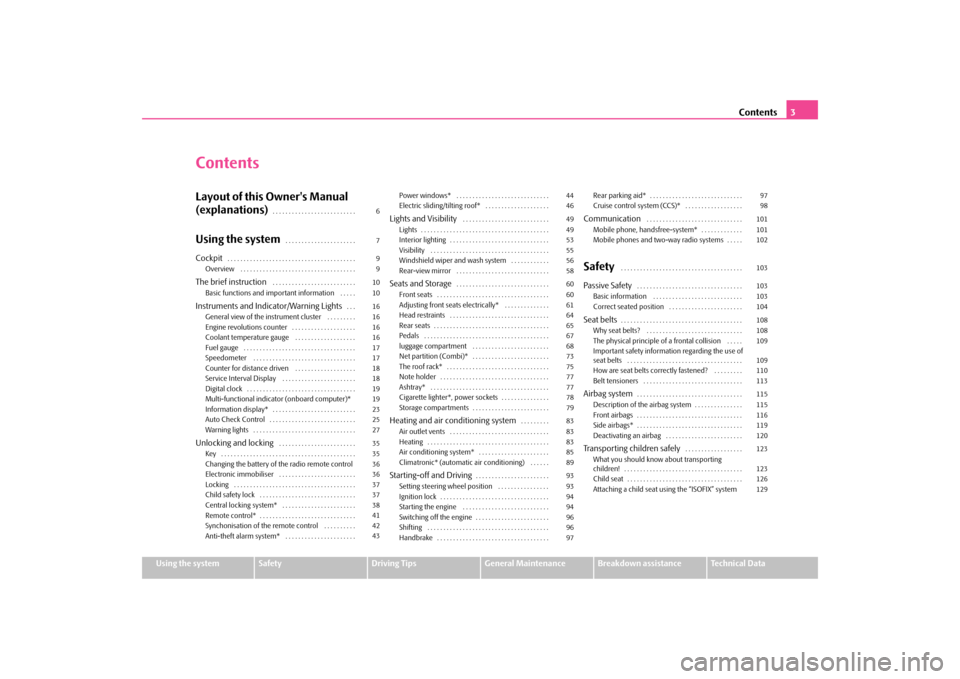
Contents
3
Using the system
Safety
Driving Tips
General Maintenance
Breakdown assistance
Technical Data
ContentsLayout of this Owner's Manual (explanations)
. . . . . . . . . . . . . . . . . . . . . . . . . .
Using the system
. . . . . . . . . . . . . . . . . . . . . .
Cockpit
. . . . . . . . . . . . . . . . . . . . . . . . . . . . . . . . . . . . . . . .
Overview . . . . . . . . . . . . . . . . . . . . . . . . . . . . . . . . . . . . The brief instruction
. . . . . . . . . . . . . . . . . . . . . . . . . .
Basic functions and important information . . . . . Instruments and Indicator/Warning Lights
. . .
General view of the instrument cluster . . . . . . . . . Engine revolutions counter . . . . . . . . . . . . . . . . . . . . Coolant temperature gauge . . . . . . . . . . . . . . . . . . . Fuel gauge . . . . . . . . . . . . . . . . . . . . . . . . . . . . . . . . . . . Speedometer . . . . . . . . . . . . . . . . . . . . . . . . . . . . . . . . Counter for distance driven . . . . . . . . . . . . . . . . . . . Service Interval Display . . . . . . . . . . . . . . . . . . . . . . . Digital clock . . . . . . . . . . . . . . . . . . . . . . . . . . . . . . . . . . Multi-functional indicator
(onboard computer)*
Information display* . . . . . . . . . . . . . . . . . . . . . . . . . . Auto Check Control . . . . . . . . . . . . . . . . . . . . . . . . . . . Warning lights . . . . . . . . . . . . . . . . . . . . . . . . . . . . . . . . Unlocking and locking
. . . . . . . . . . . . . . . . . . . . . . . .
Key . . . . . . . . . . . . . . . . . . . . . . . . . . . . . . . . . . . . . . . . . . Changing the battery of the radio remote controlElectronic immobiliser . . . . . . . . . . . . . . . . . . . . . . . . Locking . . . . . . . . . . . . . . . . . . . . . . . . . . . . . . . . . . . . . . Child safety lock . . . . . . . . . . . . . . . . . . . . . . . . . . . . . . Central locking system* . . . . . . . . . . . . . . . . . . . . . . . Remote control* . . . . . . . . . . . . . . . . . . . . . . . . . . . . . . Synchonisation of the remote control . . . . . . . . . . Anti-theft alarm system* . . . . . . . . . . . . . . . . . . . . . .
Power windows* . . . . . . . . . . . . . . . . . . . . . . . . . . . . . Electric sliding/tilting roof* . . . . . . . . . . . . . . . . . . . . Lights and Visibility
. . . . . . . . . . . . . . . . . . . . . . . . . . .
Lights . . . . . . . . . . . . . . . . . . . . . . . . . . . . . . . . . . . . . . . . Interior lighting . . . . . . . . . . . . . . . . . . . . . . . . . . . . . . . Visibility . . . . . . . . . . . . . . . . . . . . . . . . . . . . . . . . . . . . . Windshield wiper and wash system . . . . . . . . . . . . Rear-view mirror . . . . . . . . . . . . . . . . . . . . . . . . . . . . . Seats and Storage
. . . . . . . . . . . . . . . . . . . . . . . . . . . . .
Front seats . . . . . . . . . . . . . . . . . . . . . . . . . . . . . . . . . . . Adjusting front seats electrically* . . . . . . . . . . . . . . Head restraints . . . . . . . . . . . . . . . . . . . . . . . . . . . . . . . Rear seats . . . . . . . . . . . . . . . . . . . . . . . . . . . . . . . . . . . . Pedals . . . . . . . . . . . . . . . . . . . . . . . . . . . . . . . . . . . . . . . luggage compartment . . . . . . . . . . . . . . . . . . . . . . . . Net partition (Combi)* . . . . . . . . . . . . . . . . . . . . . . . . The roof rack* . . . . . . . . . . . . . . . . . . . . . . . . . . . . . . . . Note holder . . . . . . . . . . . . . . . . . . . . . . . . . . . . . . . . . . Ashtray* . . . . . . . . . . . . . . . . . . . . . . . . . . . . . . . . . . . . . Cigarette lighter*, power sockets . . . . . . . . . . . . . . . Storage compartments . . . . . . . . . . . . . . . . . . . . . . . . Heating and air conditioning system
. . . . . . . . .
Air outlet vents . . . . . . . . . . . . . . . . . . . . . . . . . . . . . . . Heating . . . . . . . . . . . . . . . . . . . . . . . . . . . . . . . . . . . . . . Air conditioning system* . . . . . . . . . . . . . . . . . . . . . . Climatronic* (automatic air conditioning) . . . . . . Starting-off and Driving
. . . . . . . . . . . . . . . . . . . . . . .
Setting steering wheel position . . . . . . . . . . . . . . . . Ignition lock . . . . . . . . . . . . . . . . . . . . . . . . . . . . . . . . . . Starting the engine . . . . . . . . . . . . . . . . . . . . . . . . . . . Switching off the engine . . . . . . . . . . . . . . . . . . . . . . . Shifting . . . . . . . . . . . . . . . . . . . . . . . . . . . . . . . . . . . . . . Handbrake . . . . . . . . . . . . . . . . . . . . . . . . . . . . . . . . . . .
Rear parking aid* . . . . . . . . . . . . . . . . . . . . . . . . . . . . . Cruise control system (CCS)* . . . . . . . . . . . . . . . . . . Communication
. . . . . . . . . . . . . . . . . . . . . . . . . . . . . .
Mobile phone, handsfree-system* . . . . . . . . . . . . . Mobile phones and two-way radio systems . . . . . Safety
. . . . . . . . . . . . . . . . . . . . . . . . . . . . . . . . . . . . . .
Passive Safety
. . . . . . . . . . . . . . . . . . . . . . . . . . . . . . . . .
Basic information . . . . . . . . . . . . . . . . . . . . . . . . . . . . Correct seated position . . . . . . . . . . . . . . . . . . . . . . . Seat belts
. . . . . . . . . . . . . . . . . . . . . . . . . . . . . . . . . . . . . .
Why seat belts? . . . . . . . . . . . . . . . . . . . . . . . . . . . . . . The physical principle of a frontal collision . . . . . Important safety information regarding the use of seat belts . . . . . . . . . . . . . . . . . . . . . . . . . . . . . . . . . . . . How are seat belts correctly fastened? . . . . . . . . . Belt tensioners . . . . . . . . . . . . . . . . . . . . . . . . . . . . . . . Airbag system
. . . . . . . . . . . . . . . . . . . . . . . . . . . . . . . . .
Description of the airbag system . . . . . . . . . . . . . . . Front airbags . . . . . . . . . . . . . . . . . . . . . . . . . . . . . . . . . Side airbags* . . . . . . . . . . . . . . . . . . . . . . . . . . . . . . . . . Deactivating an airbag . . . . . . . . . . . . . . . . . . . . . . . . Transporting children safely
. . . . . . . . . . . . . . . . . .
What you should know about transporting children! . . . . . . . . . . . . . . . . . . . . . . . . . . . . . . . . . . . . . Child seat . . . . . . . . . . . . . . . . . . . . . . . . . . . . . . . . . . . . Attaching a child seat using the “ISOFIX” system
6 7 9 9 10 10 16 16 1616171718181919232527 35 35 3636373738414243
44 46 49 49 53555658 60 60 6164656768737577777879 83 83 838589 93 93 9494969697
97 98 101 101 102 103 103 103 104 108 108 109 109 110113 115 115 116 119 120 123 123 126129
s2g8.b.book Page 3 Tuesday, April 7, 2009 8:53 AM
Page 17 of 224
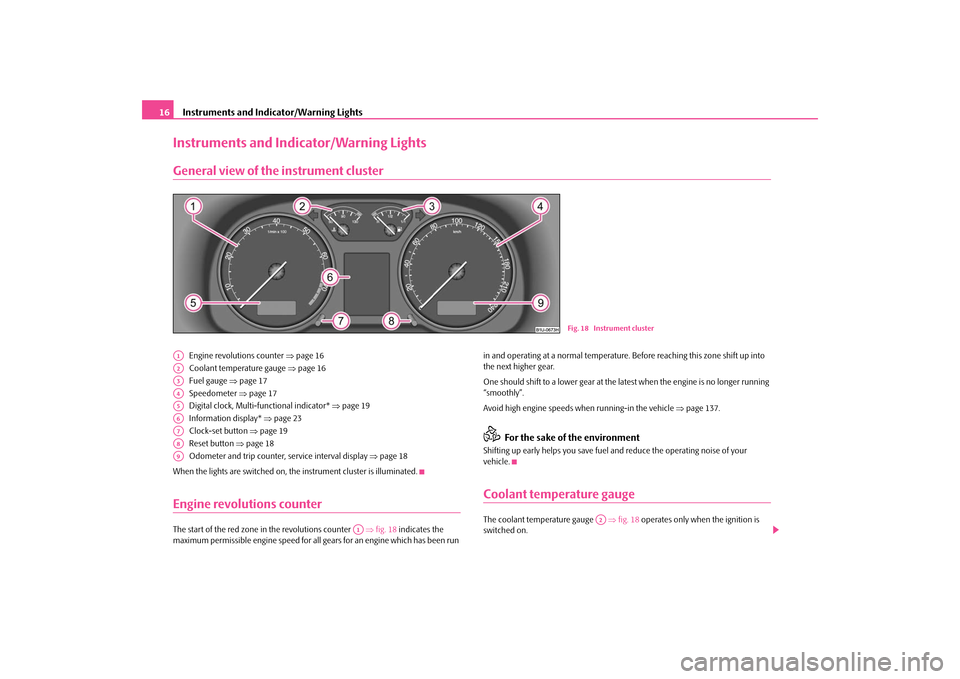
Instruments and Indicator/Warning Lights
16
Instruments and Indicator/Warning LightsGeneral view of the instrument cluster
Engine revolutions counter
⇒page 16
Coolant temperature gauge
⇒page 16
Fuel gauge
⇒page 17
Speedometer
⇒page 17
Digital clock, Multi-functional indicator*
⇒page 19
Information display*
⇒page 23
Clock-set button
⇒page 19
Reset button
⇒page 18
Odometer and trip counter, service interval display
⇒page 18
When the lights are switched on, the instrument cluster is illuminated.Engine revolutions counterThe start of the red zone in the revolutions counter
⇒fig. 18
indicates the
maximum permissible engine speed for all gears for an engine which has been run
in and operating at a normal temperature.
Before reaching this zone shift up into
the next higher gear. One should shift to a lower gear at the late
st when the engine is no longer running
“smoothly”. Avoid high engine speeds
when running-in the vehicle
⇒page 137.
For the sake of the environment
Shifting up early helps yo
u save fuel and reduce the operating noise of your
vehicle.Coolant temperature gaugeThe coolant temperature gauge
⇒fig. 18
operates only when the ignition is
switched on.
Fig. 18 Instrument cluster
A1A2A3A4A5A6A7A8A9
A1
A2
s2g8.b.book Page 16 Tuesday, April 7, 2009 8:53 AM
Page 18 of 224
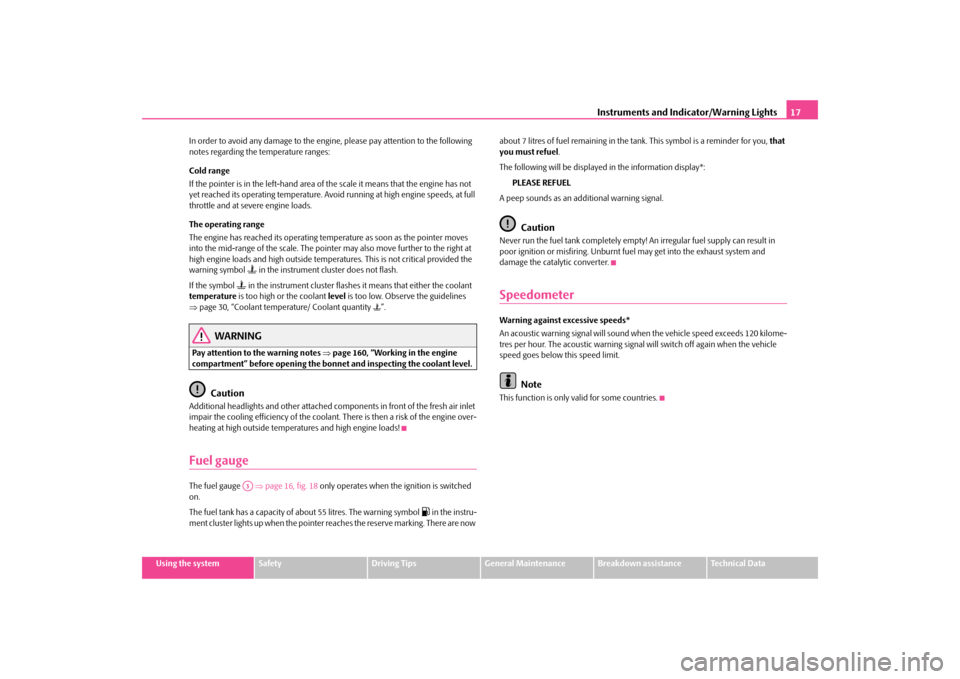
Instruments and Indicator/Warning Lights
17
Using the system
Safety
Driving Tips
General Maintenance
Breakdown assistance
Technical Data
In order to avoid any damage to the engine
, please pay attention to the following
notes regarding the temperature ranges: Cold range If the pointer is in the left-hand area of the scale it means that the engine has not yet reached its operating temperature. Avoid
running at high engine speeds, at full
throttle and at severe engine loads. The operating range The engine has reached its operating temp
erature as soon as the pointer moves
into the mid-range of the scale. The pointe
r may also move further to the right at
high engine loads and high outside temperat
ures. This is not critical provided the
warning symbol
in the instrument cluster does not flash.
If the symbol
in the instrument cluster flashes it means that either the coolant
temperature
is too high or the coolant
level
is too low. Observe the guidelines
⇒ page 30, “Coolant temperature/ Coolant quantity
”.
WARNING
Pay attention to the warning notes
⇒page 160, “Working in the engine
compartment” before opening the bonnet and inspecting the coolant level.
Caution
Additional headlights and other attached co
mponents in front of the fresh air inlet
impair the cooling efficiency of the coolant. There is then a risk of the engine over- heating at high outside temperatures and high engine loads!Fuel gaugeThe fuel gauge
⇒page 16, fig. 18
only operates when the ignition is switched
on. The fuel tank has a capacity of about 55 litres. The warning symbol
in the instru-
ment cluster lights up when the pointer reaches the reserve marking. There are now
about 7 litres of fuel remaining in the tank. This symbol is a reminder for you,
that
you must refuel
.
The following will be displayed in the information display*:
PLEASE REFUEL
A peep sounds as an additional warning signal.
Caution
Never run the fuel tank completely empty! An irregular fuel supply can result in poor ignition or misfiring. Unburnt fuel may get into the exhaust system and damage the catalytic converter.SpeedometerWarning against excessive speeds* An acoustic warning signal will sound when the vehicle speed exceeds 120 kilome- tres per hour. The acoustic warning signal
will switch off again when the vehicle
speed goes below this speed limit.
Note
This function is only
valid for some countries.
A3
s2g8.b.book Page 17 Tuesday, April 7, 2009 8:53 AM
Page 26 of 224
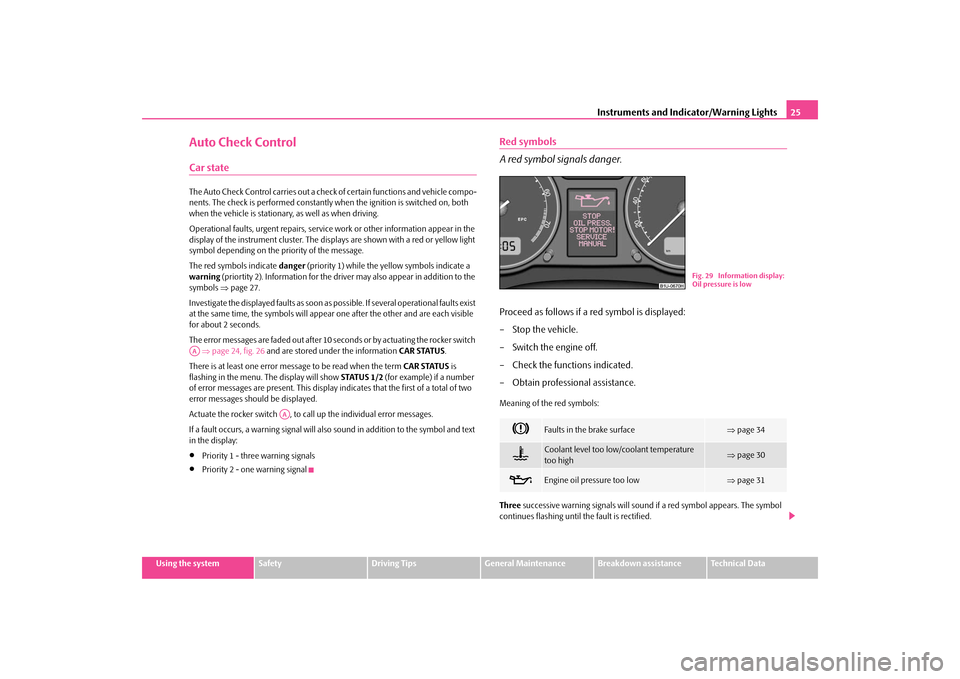
Instruments and Indicator/Warning Lights
25
Using the system
Safety
Driving Tips
General Maintenance
Breakdown assistance
Technical Data
Auto Check ControlCar stateThe Auto Check Control carries out a check of certain functions and vehicle compo- nents. The check is performed constantly
when the ignition is switched on, both
when the vehicle is stationary, as well as when driving. Operational faults, urgent repairs, service
work or other information appear in the
display of the instrument cluster. The disp
lays are shown with a red or yellow light
symbol depending on the priority of the message. The red symbols indicate
danger
(priority 1) while the yellow symbols indicate a
warning
(priortity 2). Information for the driver
may also appear in addition to the
symbols
⇒page 27.
Investigate the displayed faults as soon as
possible. If several operational faults exist
at the same time, the symbols will appear
one after the other and are each visible
for about 2 seconds. The error messages are faded out after 10 seconds or by actuating the rocker switch ⇒page 24, fig. 26
and are stored under the information
CAR STATUS
.
There is at least one error message to be read when the term
CAR STATUS
is
flashing in the menu. The display will show
STATUS 1/2
(for example) if a number
of error messages are present. This display
indicates that the first of a total of two
error messages should be displayed. Actuate the rocker switch , to call up the individual error messages.If a fault occurs, a warning signal will also sound in addition to the symbol and text in the display:•
Priority 1 - three warning signals
•
Priority 2 - one warning signal
Red symbols A red symbol signals danger.Proceed as follows if a red symbol is displayed: – Stop the vehicle.– Switch the engine off. – Check the functions indicated. – Obtain professional assistance.Meaning of the red symbols: Three
successive warning signals will sound if a red symbol appears. The symbol
continues flashing until
the fault is rectified.
AA
AA
Faults in the brake surface
⇒page 34
Coolant level too low/coolant temperature too high
⇒ page 30
Engine oil pressure too low
⇒page 31
Fig. 29 Information display: Oil pressure is low
s2g8.b.book Page 25 Tuesday, April 7, 2009 8:53 AM
Page 29 of 224
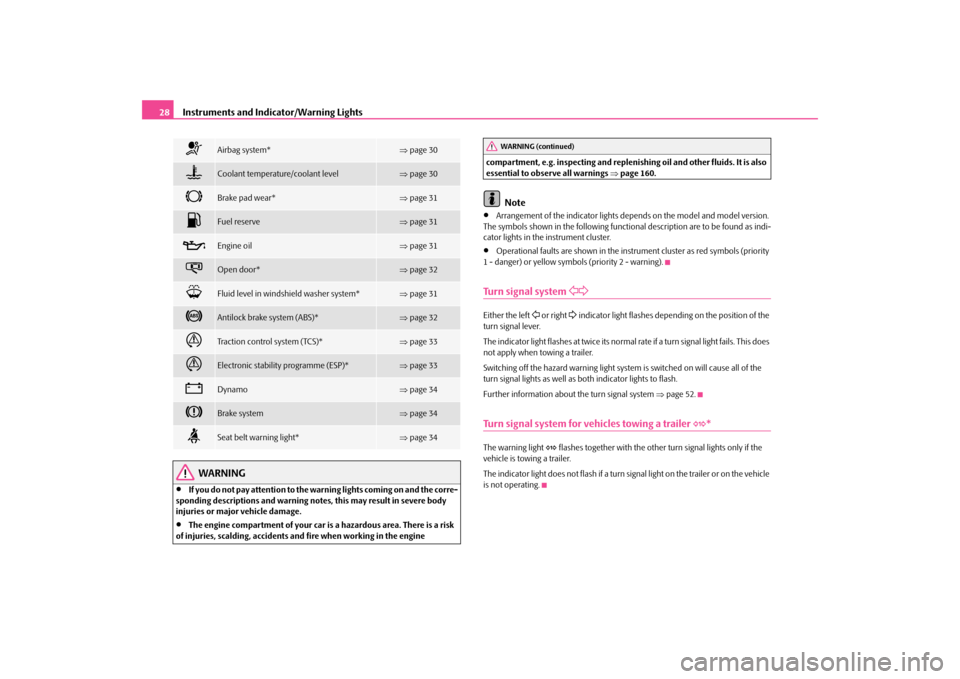
Instruments and Indicator/Warning Lights
28
WARNING
•
If you do not pay attention to the wa
rning lights coming on and the corre-
sponding descriptions and warning notes, this may result in severe body injuries or major vehicle damage.•
The engine compartment of your car is
a hazardous area. There is a risk
of injuries, scalding, accidents and
fire when working in the engine
compartment, e.g. inspecting and replenis
hing oil and other fluids. It is also
essential to obse
rve all warnings
⇒page 160.
Note
•
Arrangement of the indicator lights depends on the model and model version.
The symbols shown in the following function
al description are to be found as indi-
cator lights in the instrument cluster.•
Operational faults are shown in the inst
rument cluster as red symbols (priority
1 - danger) or yellow symbols (priority 2 - warning).Turn signal system
Either the left
or right
indicator light flashes depending on the position of the
turn signal lever. The indicator light flashes at twice its normal rate if a turn signal light fails. This does not apply when towing a trailer. Switching off the hazard warning light system is switched on will cause all of the turn signal lights as well as both indicator lights to flash. Further information about the turn signal system
⇒page 52.
Turn signal system for vehicles towing a trailer
*
The warning light
flashes together with the other turn signal lights only if the
vehicle is towing a trailer. The indicator light does not flash if a turn si
gnal light on the trailer or on the vehicle
is not operating.
Airbag system*
⇒ page 30
Coolant temperature/coolant level
⇒page 30
Brake pad wear*
⇒page 31
Fuel reserve
⇒page 31
Engine oil
⇒page 31
Open door*
⇒page 32
Fluid level in windshield washer system*
⇒page 31
Antilock brake system (ABS)*
⇒page 32
Traction control system (TCS)*
⇒page 33
Electronic stability programme (ESP)*
⇒page 33
Dynamo
⇒page 34
Brake system
⇒page 34
Seat belt warning light*
⇒page 34
WARNING (continued)
s2g8.b.book Page 28 Tuesday, April 7, 2009 8:53 AM
Page 31 of 224
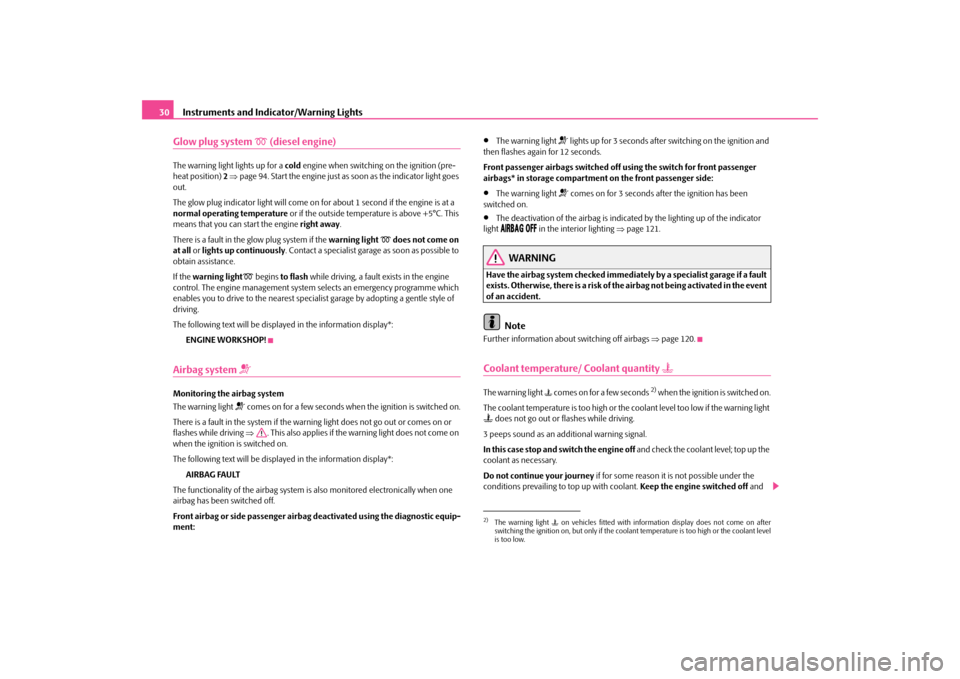
Instruments and Indicator/Warning Lights
30
Glow plug system
(diesel engine)
The warning light lights up for a
cold
engine when switching on the ignition (pre-
heat position)
2 ⇒page 94. Start the engine just as soon as the indicator light goes
out. The glow plug indicator light will come on for about 1 second if the engine is at a normal operating temperature
or if the outside temperature is above +5°C. This
means that you can start the engine
right away
.
There is a fault in the glow plug system if the
warning light
does not come on
at all
or lights up continuously
. Contact a specialist garage
as soon as possible to
obtain assistance. If the
warning light
begins
to flash
while driving, a fault exists in the engine
control. The engine management system
selects an emergency programme which
enables you to drive to the nearest specialist garage by adopting a gentle style of driving. The following text will be displayed in the information display*:
ENGINE WORKSHOP!
Airbag system
Monitoring the airbag system The warning light
comes on for a few seconds when the ignition is switched on.
There is a fault in the system if the warn
ing light does not go out or comes on or
flashes while driving
⇒
. This also applies if the warning light does not come on
when the ignition is switched on. The following text will be displayed in the information display*:
AIRBAG FAULT
The functionality of the airbag system is also monitored electronically when one airbag has been switched off. Front airbag or side pass
enger airbag deactivated us
ing the diagnostic equip-
ment:
•
The warning light
lights up for 3 seconds after switching on the ignition and
then flashes again for 12 seconds. Front passenger airbags switched off
using the switch for front passenger
airbags* in storage compartment on the front passenger side:•
The warning light
comes on for 3 seconds after the ignition has been
switched on.•
The deactivation of the airb
ag is indicated by the ligh
ting up of the indicator
light
in the interior lighting
⇒page 121.
WARNING
Have the airbag system ch
ecked immediately by a specialist garage if a fault
exists. Otherwise, there is a risk of th
e airbag not being activated in the event
of an accident.
Note
Further information about switching off airbags
⇒page 120.
Coolant temperature/ Coolant quantity
The warning light
comes on for a few seconds
2) w h e n t h e i g n i t i o n i s s w i tc h e d o n .
The coolant temperature is too high or the coolant level too low if the warning light does not go out or flashes while driving.3 peeps sound as an additional warning signal.In this case stop and switch the engine off
and check the coolant level; top up the
coolant as necessary. Do not continue your journey
if for some reason it
is not possible under the
conditions prevailing to
top up with coolant.
Keep the engine switched off
and
2)The warning light
on vehicles fitted with information display does not come on after
switching the ignition on, but only if the coola
nt temperature is too high or the coolant level
is too low.
s2g8.b.book Page 30 Tuesday, April 7, 2009 8:53 AM
Page 32 of 224
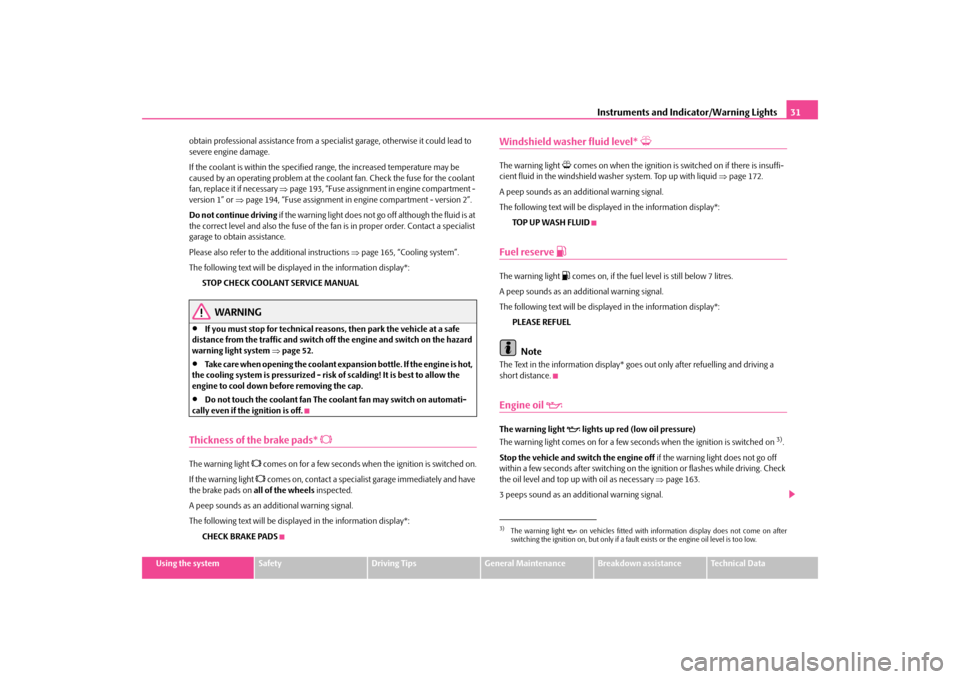
Instruments and Indicator/Warning Lights
31
Using the system
Safety
Driving Tips
General Maintenance
Breakdown assistance
Technical Data
obtain professional assistance from a specialist garage, otherwise it could lead to severe engine damage. If the coolant is within the specified
range, the increased temperature may be
caused by an operating problem at the coolant fan. Check the fuse for the coolant fan, replace it if necessary
⇒page 193, “Fuse assignment in engine compartment -
version 1” or
⇒page 194, “Fuse assignment in en
gine compartment - version 2”.
Do not continue driving
if the warning light does not go
off although the fluid is at
the correct level and also the fuse of the fa
n is in proper order. Contact a specialist
garage to obtain assistance. Please also refer to the additional instructions
⇒page 165, “Cooling system”.
The following text will be displayed in the information display*:
STOP CHECK COOLANT SERVICE MANUAL
WARNING
•
If you must stop for technical reasons, then park the vehicle at a safe
distance from the traffic
and switch off the engine and switch on the hazard
warning light system
⇒page 52.
•
Take care when opening the coolant expa
nsion bottle. If the engine is hot,
the cooling system is pressurized - risk of scalding! It is best to allow the engine to cool down before removing the cap.•
Do not touch the coolant fan The coolant fan may switch on automati-
cally even if the ignition is off.Thickness of the brake pads*
The warning light
comes on for a few seconds when the ignition is switched on.
If the warning light
comes on, contact a specialist garage immediately and have
the brake pads on
all of the wheels
inspected.
A peep sounds as an addi
tional warning signal.
The following text will be displayed in the information display*:
CHECK BRAKE PADS
Windshield washer fluid level*
The warning light
comes on when the ignition is
switched on if there is insuffi-
cient fluid in the windshield washer system. Top up with liquid
⇒page 172.
A peep sounds as an additional warning signal.The following text will be displayed in the information display*:
TOP UP WASH FLUID
Fuel reserve
The warning light
comes on, if the fuel level is still below 7 litres.
A peep sounds as an additional warning signal.The following text will be displayed in the information display*:
PLEASE REFUELNote
The Text in the information display* goes out only after refuelling and driving a short distance.Engine oil
The warning light
lights up red (low oil pressure)
The warning light comes on for a few seconds when the ignition is switched on
3).
Stop the vehicle and sw
itch the engine off
if the warning light does not go off
within a few seconds after switching on the ignition or flashes while driving. Check the oil level and top up with oil as necessary
⇒page 163.
3 peeps sound as an additional warning signal.3)The warning light
on vehicles fitted with information display does not come on after
switching the ignition on, but only if a fault exists or the engine oil level is too low.
s2g8.b.book Page 31 Tuesday, April 7, 2009 8:53 AM
Page 85 of 224
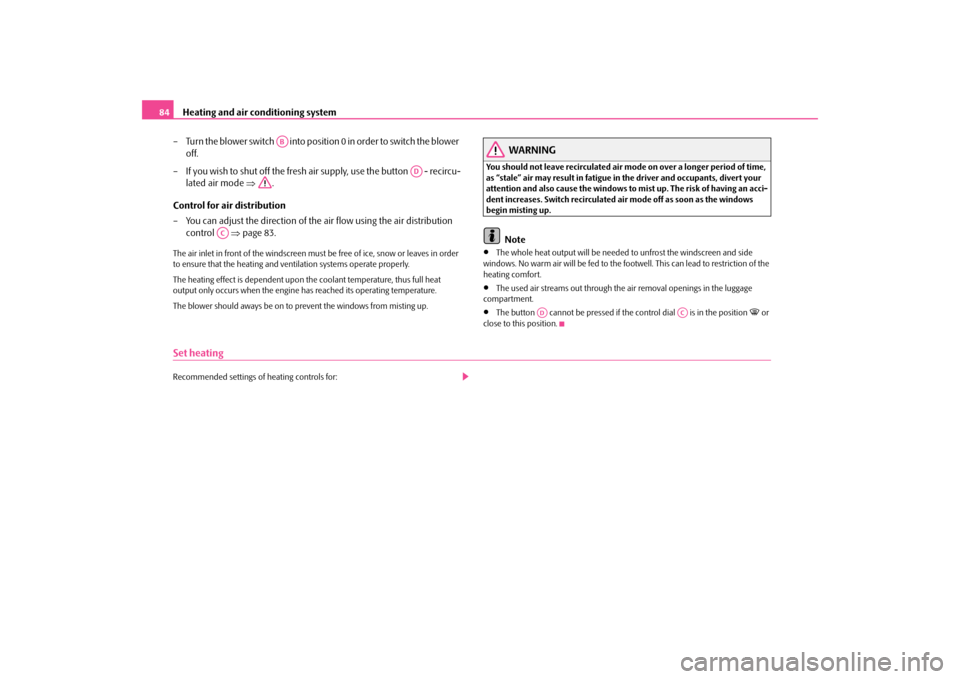
Heating and air conditioning system
84
– Turn the blower switch into position 0 in order to switch the blower
off.
– If you wish to shut off the fresh air supply, use the button - recircu-
lated air mode
⇒
.
Control for air distribution – You can adjust the direction of the air flow using the air distribution
control
⇒
page 83.
The air inlet in front of the windscreen must be free of ice, snow or leaves in order to ensure that the heating and ventilation systems operate properly. The heating effect is dependent upon th
e coolant temperature, thus full heat
output only occurs when the engine
has reached its operating temperature.
The blower should aways be on to prevent the windows from misting up.
WARNING
You should not leave recirculated air mode on over a longer period of time, as “stale” air may result in fatigue in the driver and occupants, divert your attention and also cause the windows to mist up. The risk of having an acci-dent increases. Switch recirculated air mode off as soon as the windows begin misting up.
Note
•
The whole heat output will be needed
to unfrost the windscreen and side
windows. No warm air will be fed to the foot
well. This can lead to restriction of the
heating comfort.•
The used air streams out through the air removal openings in the luggage
compartment.•
The button cannot be pressed if the
control dial is in the position
or
close to this position.
Set heatingRecommended settings of heating controls for:
AB
AD
AC
AD
AC
s2g8.b.book Page 84 Tuesday, April 7, 2009 8:53 AM
Page 87 of 224
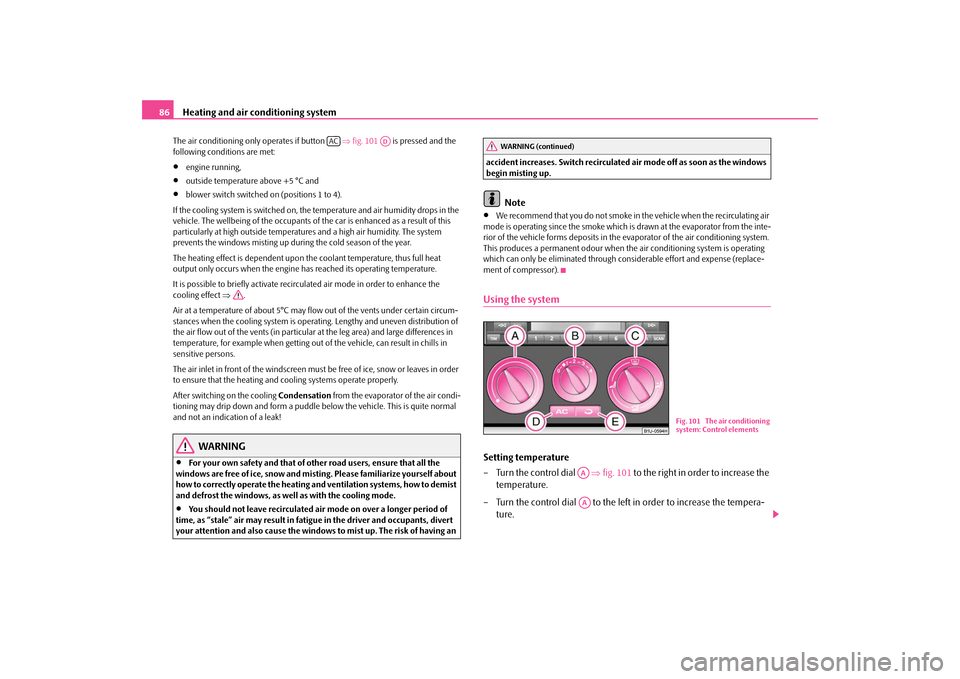
Heating and air conditioning system
86
The air conditioning only operates if button
⇒fig. 101
is pressed and the
following conditions are met:•
engine running,
•
outside temperature above +5 °C and
•
blower switch switched
on (positions 1 to 4).
If the cooling system is switched on, the temperature and air humidity drops in the vehicle. The wellbeing of the occupants of
the car is enhanced as a result of this
particularly at high outside temperatures and a high air humidity. The system prevents the windows misting up during the cold season of the year. The heating effect is dependent upon th
e coolant temperature, thus full heat
output only occurs when the engine
has reached its operating temperature.
It is possible to briefly activate recirc
ulated air mode in order to enhance the
cooling effect
⇒
.
Air at a temperature of about 5°C may flow
out of the vents under certain circum-
stances when the cooling system is operating. Lengthy and uneven distribution of the air flow out of the vents (in particular at the leg area) and large differences in temperature, for example when getting out of
the vehicle, can result in chills in
sensitive persons. The air inlet in front of the windscreen must be free of ice, snow or leaves in order to ensure that the heating and cooling systems operate properly. After switching on the cooling
Condensation
from the evaporator of the air condi-
tioning may drip down and form a puddle
below the vehicle. This is quite normal
and not an indication of a leak!
WARNING
•
For your own safety and that of other road users, ensure that all the
windows are free of ice, snow and mistin
g. Please familiarize yourself about
how to correctly operate th
e heating and ventilation systems, how to demist
and defrost the windows, as well as with the cooling mode.•
You should not leave recirculated air mode on over a longer period of
time, as “stale” air may result in fatigue in the driver and occupants, divert your attention and also cause the windows to mist up. The risk of having an
accident increases. Switch recirculated air mode off as soon as the windows begin misting up.
Note
•
We recommend that you do not smoke in the vehicle when the recirculating air
mode is operating since the smoke which is drawn at the evaporator from the inte- rior of the vehicle forms deposits in the
evaporator of the air conditioning system.
This produces a permanent odour when th
e air conditioning system is operating
which can only be eliminated through co
nsiderable effort and expense (replace-
ment of compressor).Using the systemSetting temperature – Turn the control dial
⇒
fig. 101
to the right in order to increase the
temperature.
– Turn the control dial to the left in order to increase the tempera-
ture.
AC
AD
WARNING (continued)
Fig. 101 The air conditioning system: Control elements
AAAA
s2g8.b.book Page 86 Tuesday, April 7, 2009 8:53 AM
Page 90 of 224
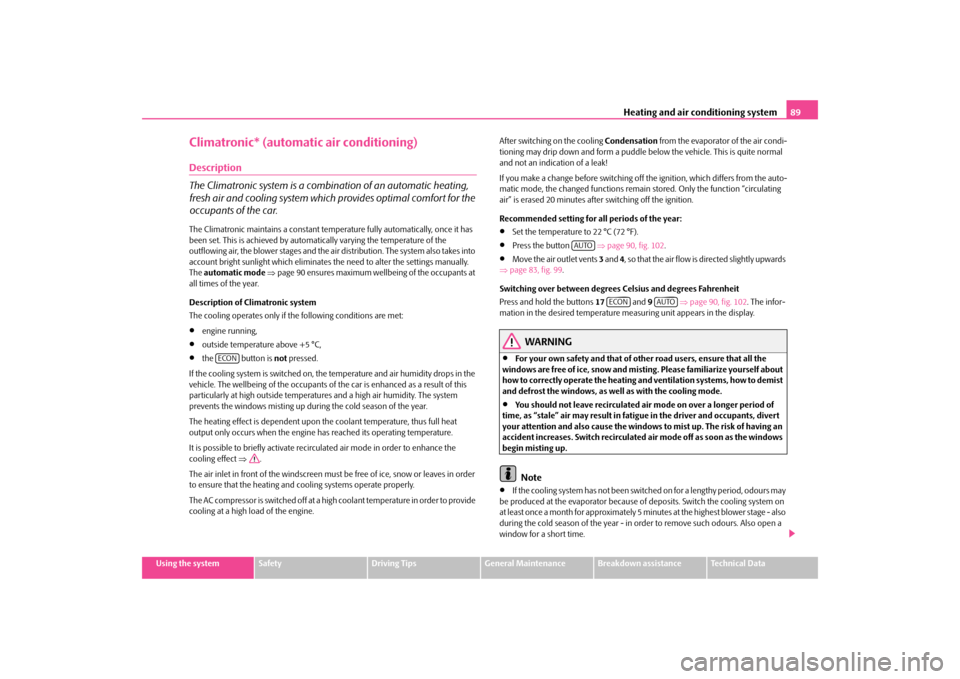
Heating and air conditioning system
89
Using the system
Safety
Driving Tips
General Maintenance
Breakdown assistance
Technical Data
Climatronic* (automatic air conditioning)Description The Climatronic system is a combin
ation of an automatic heating,
fresh air and cooling system which provides optimal comfort for the occupants of the car.The Climatronic maintains a constant temp
erature fully automatically, once it has
been set. This is achiev
ed by automatically varying the temperature of the
outflowing air, the blower stages and the ai
r distribution. The system also takes into
account bright sunlight which eliminates
the need to alter the settings manually.
The
automatic mode
⇒page 90 ensures maximum wellbeing of the occupants at
all times of the year. Description of Climatronic system The cooling operates only if the following conditions are met:•
engine running,
•
outside temperature above +5 °C,
•
the button is
not
pressed.
If the cooling system is switched on, the temperature and air humidity drops in the vehicle. The wellbeing of the occupants of
the car is enhanced as a result of this
particularly at high outs
ide temperatures and a high air humidity. The system
prevents the windows misting up during the cold season of the year. The heating effect is dependent upon th
e coolant temperature, thus full heat
output only occurs when the engine has reached its operating temperature. It is possible to briefly activate recirc
ulated air mode in order to enhance the
cooling effect
⇒
.
The air inlet in front of the windscreen must be free of ice, snow or leaves in order to ensure that the heating and cooling systems operate properly. The AC compressor is switched off at a hi
gh coolant temperature in order to provide
cooling at a high load of the engine.
After switching on the cooling
Condensation
from the evaporator of the air condi-
tioning may drip down and form a puddle be
low the vehicle. This is quite normal
and not an indication of a leak! If you make a change before switching off
the ignition, which differs from the auto-
matic mode, the changed functions remain
stored. Only the function “circulating
air” is erased 20 minutes after switching off the ignition. Recommended setting for all periods of the year:•
Set the temperature to 22 °C (72 °F).
•
Press the button
⇒page 90, fig. 102
.
•
Move the air outlet vents
3 and
4, s o t h a t th e a i r f l o w i s d i re c t e d s l i g h tl y u pw a rd s
⇒ page 83, fig. 99
.
Switching over between degrees
Celsius and degrees Fahrenheit
Press and hold the buttons
17 and
9
⇒page 90, fig. 102
. The infor-
mation in the desired temperature measuring unit appears in the display.
WARNING
•
For your own safety and that of other road users, ensure that all the
windows are free of ice, snow and mistin
g. Please familiarize yourself about
how to correctly operate th
e heating and ventilation systems, how to demist
and defrost the windows, as well as with the cooling mode.•
You should not leave recirculated air mode on over a longer period of
time, as “stale” air may result in fatigue in the driver and occupants, divert your attention and also cause the windows to mist up. The risk of having an accident increases. Switch recirculated air mode off as soon as the windows begin misting up.
Note
•
If the cooling system has not been switched on for a lengthy period, odours may
be produced at the evaporator because of
deposits. Switch the cooling system on
at least once a month for approximately 5 mi
nutes at the highest blower stage - also
during the cold season of the year - in
order to remove such odours. Also open a
window for a short time.
ECON
AUTO
ECON
AUTO
s2g8.b.book Page 89 Tuesday, April 7, 2009 8:53 AM